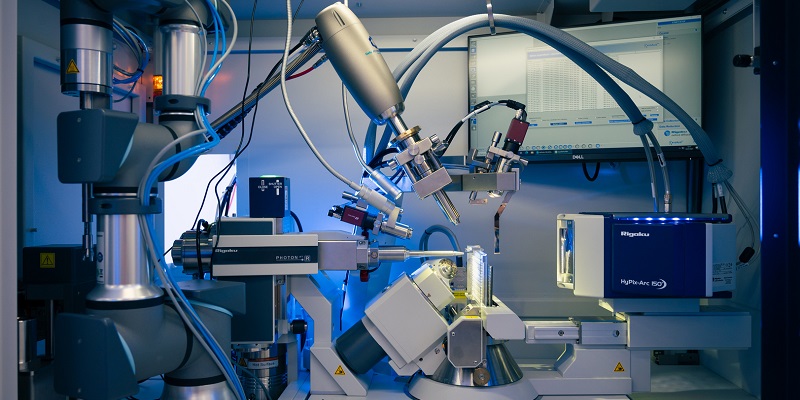
Biomedical Technologies
Biomedical Technologies spans the three main themes within YBRI. Research in this area encompasses a wide range of topics, all with the goal of improving how we diagnose, treat, and understand disease.
Biomedical Technologies unites the life, medical, physical and data sciences to support the translation of research excellence into real-world solutions.
Our areas of expertise cover:
1. Diagnostics
- Sensors to detect biomarkers for disease
- Computational diagnostics
- Medical Imaging (including optical, PET and MRI)
2. Treatment/Rehabilitation
- Medical and surgical devices
- Biomechanics and bionics
- Drug delivery
- Augmented and virtual reality environments
3. Understanding Disease
- Computational neuroscience and neural computing
- Bioinspired algorithms
- Analytical technologies
Diagnostics
Low-cost, point-of-care diagnostic devices have been developed that can rapidly detect and quantify biomarkers of disease. These technologies provide rapid, cost effective testing and assessment of disease when are where needed enabling early diagnosis and targeted intervention. For example, in the context of antimicrobial resistance, we have demonstrated biosensors that can identify bacteria and their susceptibility to antimicrobials (Krauss, Johnson, Thomas, Duhme-Klair). Researchers have also developed a personal metabolome machine to detect and map multiple metabolites; helping with the prognosis of diseases related to metabolome such as different forms of cancers, diabetes and coronary artery diseases (Patil).
In addition to biosensors, new spectroscopic diagnostic tools are also in development. These include label-free analysis of blood serum using ultrafast 2D-IR spectroscopy (Hunt) and Raman spectroscopy for biomolecular fingerprinting for a range of health conditions including cancer (Hancock).
Technology automating the diagnosis and assessment of Parkinson’s disease and other neurodegenerative conditions based on the measurement and analysis of movement disorders and visuo-spatial ability has been developed (Smith). Features associated with symptoms of these neurological conditions are used to train novel biologically inspired algorithms to aid diagnosis, monitoring and administration of medication. This has the potential to transform clinical practice allowing patients to be monitored with greater accuracy than previously possible. These computational diagnostic devices are in clinical use in leading medical centres worldwide.
Medical Imaging at York spans single molecular microscopy techniques to investigate complex biological processes in order to drive the rational design of next-generation therapeutics (Quinn, Leake). Development of novel multimodal biomedical imaging systems in areas such as neuroimaging and oncology and application of hyperpolarisation techniques for use in Nuclear magnetic resonance (NMR) and Magnetic resonance imaging (MRI) (Duckett, Chauhan)
Contact us
York Biomedical Research Institute
ybri
Department of Biology, Wentworth Way, University of York, York, YO10 5NG
@@YBRI_UoY
Treatment/ Rehabilitation
Augmented and virtual reality environments: The Laboratory for Investigative Virtual Environments (LIVE) specialises in medical diagnostics and rehabilitation technology based on augmented and virtual reality environments that capture and simulate the motion e.g. gait of a patient. The technology can not only be used to understand cognition but can also be applied to diagnose a range of medical conditions that influence human movement and support rehabilitation of patients with conditions such as stroke or osteoarthritis (Pelah).
Musculoskeletal biomechanics and bionics: Understanding how humans move has been a fascination for centuries. Ellison’s bionics lab at York is integrating knowledge on musculoskeletal biomechanics with neurophysiology to develop a full understanding of how people move. This work has produced novel solutions in bionics, such as methods of event detection during movement and improved understanding of failure modes in total knee arthroplasty.
Medical Robotics involves development of technological solutions for human ailments. This involves inter-disciplinary research by exploring multiple domains of basic sciences, microbiology, engineering, and robotics. Healthcare robotics group focusses on developing AI-enabled solutions for surgical, in-vivo diagnosis and rehabilitation applications. Soft robotics form the backbone core of the technology development at this group. Some areas of research focus have been early cancer diagnosis, therapeutics, surgical interventions and neurological disorders (Chauhan).
Understanding Disease
In addition to developing technologies that have direct application in healthcare settings, such as Drug Discovery, we also develop new hardware and software tools that help us understand and ultimately better manage disease. For example, we have demonstrated a novel analytical technology, named Phenospot, that allows us to map the three-dimensional (x, y, time) distribution of multiple cell-secreted signalling molecules with single cell resolution. By understanding when and where these signalling molecules are secreted, we are able to better understand how the behaviour and function of cells within our bodies are coordinated.
Computational neuroscience involves interaction between the Physical Sciences (Engineering, Mathematics, Statistics) and Life Sciences (Neuroscience, Psychology, Neurophysiology). Researchers across these fields aim to understand the operation of the nervous system through the use of techniques which include mathematical analysis of neural signals, and modelling of the electrical activity in single neurones and groups of neurones (Halliday).
Contact us
York Biomedical Research Institute
ybri
Department of Biology, Wentworth Way, University of York, York, YO10 5NG
@@YBRI_UoY

